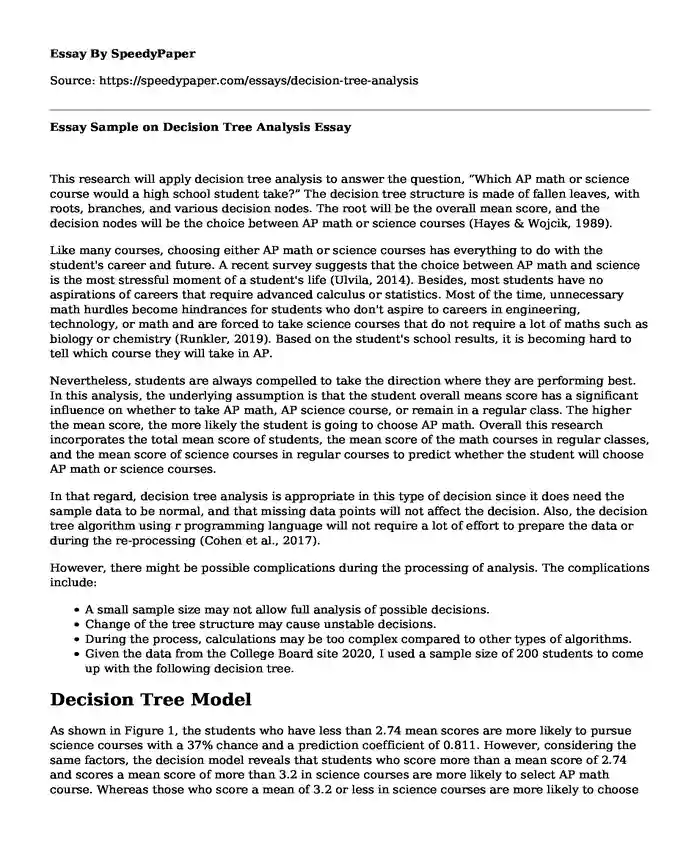
| Essay type: | Analytical essays |
| Categories: | Learning Knowledge School Mathematics |
| Pages: | 3 |
| Wordcount: | 748 words |
This research will apply decision tree analysis to answer the question, “Which AP math or science course would a high school student take?” The decision tree structure is made of fallen leaves, with roots, branches, and various decision nodes. The root will be the overall mean score, and the decision nodes will be the choice between AP math or science courses (Hayes & Wojcik, 1989).
Like many courses, choosing either AP math or science courses has everything to do with the student's career and future. A recent survey suggests that the choice between AP math and science is the most stressful moment of a student's life (Ulvila, 2014). Besides, most students have no aspirations of careers that require advanced calculus or statistics. Most of the time, unnecessary math hurdles become hindrances for students who don't aspire to careers in engineering, technology, or math and are forced to take science courses that do not require a lot of maths such as biology or chemistry (Runkler, 2019). Based on the student's school results, it is becoming hard to tell which course they will take in AP.
Nevertheless, students are always compelled to take the direction where they are performing best. In this analysis, the underlying assumption is that the student overall means score has a significant influence on whether to take AP math, AP science course, or remain in a regular class. The higher the mean score, the more likely the student is going to choose AP math. Overall this research incorporates the total mean score of students, the mean score of the math courses in regular classes, and the mean score of science courses in regular courses to predict whether the student will choose AP math or science courses.
In that regard, decision tree analysis is appropriate in this type of decision since it does need the sample data to be normal, and that missing data points will not affect the decision. Also, the decision tree algorithm using r programming language will not require a lot of effort to prepare the data or during the re-processing (Cohen et al., 2017).
However, there might be possible complications during the processing of analysis. The complications include:
- A small sample size may not allow full analysis of possible decisions.
- Change of the tree structure may cause unstable decisions.
- During the process, calculations may be too complex compared to other types of algorithms.
- Given the data from the College Board site 2020, I used a sample size of 200 students to come up with the following decision tree.
Decision Tree Model
As shown in Figure 1, the students who have less than 2.74 mean scores are more likely to pursue science courses with a 37% chance and a prediction coefficient of 0.811. However, considering the same factors, the decision model reveals that students who score more than a mean score of 2.74 and scores a mean score of more than 3.2 in science courses are more likely to select AP math course. Whereas those who score a mean of 3.2 or less in science courses are more likely to choose science courses. For the student to select a science course AP, he or she should score a mean of more than 3.2 in sciences. However, the model has not been considered other factors, which include student skills, family background, ethnicity, student loan, family income, and student co-curricular activities. These factors may significantly influence the decision of the student to select an AP math or science course.
References
Chauhan, N. S. (2020). Decision Tree Algorithm - Explained. Retrieved 23 July 2020, from https://towardsdatascience.com/decision-tree-algorithm-explained-83beb6e78ef4.
Cohen, L., Manion, L., & Morrison, K. (2017). Research questions. Research Methods in Education, 32(10), 165–172. https://doi.org/10.4324/9781315456539-10
Decision Tree Analysis: Choosing by Projecting "Expected Outcomes." (202). Retrieved 23 July 2020, from https://www.mindtools.com/dectree.html
Dhiraj, K. (2019). Top 5 advantages and disadvantages of the Decision Tree Algorithm. Retrieved 23 July 2020, from https://medium.com/@dhiraj8899/top-5-advantages-and-disadvantages-of-decision-tree-algorithm-428ebd199d9a
Doolan, D., Winters, J., & Nouredini, S. (2017). Real Data Analysis: Answering Research Questions. Analyzing Quantitative Data, 5(9), 249–305. https://doi.org/10.4135/9781849208604.n9
Hayes, K. W., & Wojcik, B. (1989). Decision Tree Structure. Physical Therapy, 69(12), htttps://doi.org/1120-1122. doi:10.1093/ptj/69.12.1120
Oliva, R. (2015). Addressing Dynamic Decision Problems Using Decision Analysis and Simulation. Analytical Methods for Dynamic Modelers, 45(4), 78–89. https://doi.org/10.7551/mitpress/9927.003.0016
Porush, D. (2018). What Makes a Good Research Question? Journal of Research Methods, 45(4), 92–95. https://doi.org/10.4135/9781526442918
Runkler, S. (2019). AP Courses and Exams. Retrieved 23 July 2020, from https://apstudents.collegeboard.org/course-index-page
Ulvila, J. (2014, 1 August). Decision Analysis Comes of Age. Retrieved 22 July 2020, from https://hbr.org/1982/09/decision-analysis-comes-of-age.
Cite this page
Essay Sample on Decision Tree Analysis. (2023, Oct 17). Retrieved from https://speedypaper.net/essays/decision-tree-analysis
Request Removal
If you are the original author of this essay and no longer wish to have it published on the SpeedyPaper website, please click below to request its removal:
- Introduction of Pluripotent Stem Cells - a Summary Paper Example for Free
- Causes of Poverty Disclosed in Our Free Essay Example
- Free Essay on Summary of Open AI Articles
- Essay Example - Cognitive Development Activities
- Essay Sample on Effects of Anthropogenic and Natural Emissions
- Healthcare Management Information - Essay Example
- Banning Cellphones in Schools: Unveiling the Drawbacks and Controversies - Report Sample
Popular categories




